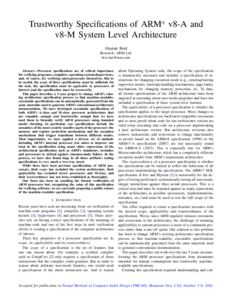Trustworthy Specifications of ARM v8-A and v8-M System Level Architecture
ARM Ltd[pdf] [slides] [url]
Proceedings of Formal Methods in Computer-Aided Design (FMCAD 2016)
Mountain View, CA, USA
October 2016
Abstract
Processor specifications are of critical importance for verifying programs, compilers, operating systems/hypervisors, and, of course, for verifying microprocessors themselves. But to be useful, the scope of these specifications must be sufficient for the task, the specification must be applicable to processors of interest and the specification must be trustworthy.
This paper describes a 5 year project to change ARM's existing architecture specification process so that machine-readable, executable specifications can be automatically generated from the same materials used to generate ARM's conventional architecture documentation. We have developed executable specifications of both ARM's A-class and M-class processor architectures that are complete enough and trustworthy enough that we have used them to formally verify ARM processors using bounded model checking. In particular, our specifications include the semantics of the most security sensitive parts of the processor: the memory and register protection mechanisms and the exception mechanisms that trigger transitions between different modes. Most importantly, we have applied a diverse set of methods including ARM's internal processor test suites to improve our trust in the specification using many other expressions of the architectural specification such as ARM's simulators, testsuites and processors to defend against common-mode failure. In the process, we have also found bugs in all those artifacts: testing specifications is very much a two-way street.
While there have been previous specifications of ARM processors, their scope has excluded the system architecture, their applicability has excluded newer processors and M-class, and their trustworthiness has not been established as thoroughly.
Our focus has been on enabling the formal verification of ARM processors but, recognising the value of this specification for verifying software, we are currently preparing a public release of the machine-readable specification.

BibTeX
@inproceedings{conf/fmcad/Reid16 , abstract = { Processor specifications are of critical importance for verifying programs, compilers, operating systems/hypervisors, and, of course, for verifying microprocessors themselves. But to be useful, the scope of these specifications must be sufficient for the task, the specification must be applicable to processors of interest and the specification must be trustworthy.This paper describes a 5 year project to change ARM's existing architecture specification process so that machine-readable, executable specifications can be automatically generated from the same materials used to generate ARM's conventional architecture documentation. We have developed executable specifications of both ARM's A-class and M-class processor architectures that are complete enough and trustworthy enough that we have used them to formally verify ARM processors using bounded model checking. In particular, our specifications include the semantics of the most security sensitive parts of the processor: the memory and register protection mechanisms and the exception mechanisms that trigger transitions between different modes. Most importantly, we have applied a diverse set of methods including ARM's internal processor test suites to improve our trust in the specification using many other expressions of the architectural specification such as ARM's simulators, testsuites and processors to defend against common-mode failure. In the process, we have also found bugs in all those artifacts: testing specifications is very much a two-way street.
While there have been previous specifications of ARM processors, their scope has excluded the system architecture, their applicability has excluded newer processors and M-class, and their trustworthiness has not been established as thoroughly.
Our focus has been on enabling the formal verification of ARM processors but, recognising the value of this specification for verifying software, we are currently preparing a public release of the machine-readable specification. } , affiliation = {ARM Ltd} , ar_file = {FMCAD_16} , ar_shortname = {FMCAD 16} , authors = {Alastair Reid} , booktitle = {Proceedings of Formal Methods in Computer-Aided Design (FMCAD 2016)} , file = {fmcad2016-trustworthy.pdf} , isbn = {978-0-9835678-6-8} , link = {https://alastairreid.github.io/papers/fmcad2016-trustworthy.pdf} , location = {Mountain View, CA, USA} , month = {October} , pages = {161-168} , png = {fmcad2016-trustworthy.png} , slides = {fmcad2016-trustworthy-slides.pdf} , title = {{T}rustworthy {S}pecifications of {A}RM v8-{A} and v8-{M} System {L}evel {A}rchitecture} , url = {https://alastairreid.github.io/papers/fmcad2016-trustworthy.pdf} , year = {2016} }